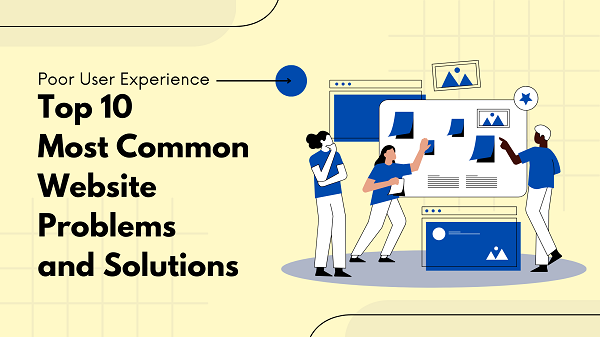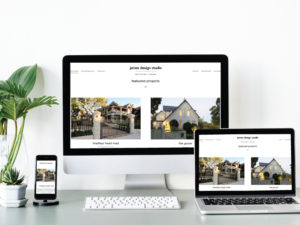During my 17 year’s journey in the web design field I have managed many website redesign projects. Most of them came to us because these websites were not performing well.
Some of them were looking good, some were fast but they were not performing well.
After working on hundreds of websites I can conclude that website design problems can cause serious issues for your website, from decreased user engagement to lost conversions.
No problem is big or small, priorities can be different but for website’s success, it’s important to understand the most common types of website design problems and how to address them.
This blog post will provide an overview of the most common website design mistakes and usability issues, including poor navigation, slow loading times, and inadequate content.
We’ll also discuss best practices for avoiding these web design issues in the future.
If you have all check points before designing a website you can come up with a properly designed website to ensure a great user experience.
Most common problems in website design
- Poor Navigation
- Slow Loading Speed
- Lack of Mobile Responsiveness
- Confusing Layout
- Poor Typography
- Lack of Accessibility
- Inconsistent Design
- Broken Links
- Lack of Calls-to-Action
- Poor Content
1. Poor Navigation:
Poor navigation is one of the most common website problems I have encountered.
It is a problem that often leads to user frustration, resulting in higher bounce rates and decreased engagement.
In order to ensure a positive user experience, it is crucial to address this issue.
Using generic labels
The first step in addressing poor navigation is to ensure that the navigation menu is intuitive and easy to understand. This means using clear labels that accurately describe the content that the user will find when they click on a particular link.
The labels should also be concise, so that the user can easily scan the menu and find what they are looking for.
It is also important to organize the menu logically, grouping similar items together and ensuring that the most important links are prioritized.
Not visible enough
Another important aspect of effective navigation is visibility. Do not forget to add a navigation menu on all pages of your website. It helps your site visitor to visit all important pages from any page of the website.
This can be achieved by placing the navigation menu in a prominent location, such as at the top of the page, and ensuring that it stands out from the rest of the content.
In addition to a visible navigation menu, it is also helpful to provide a search bar. This allows users to quickly find specific information, without having to navigate through multiple pages.
The search bar should be prominently placed on the page and should be easy to use, with clear instructions on how to use it effectively.
2. Slow Loading Speed:
Slow loading speed is one of the most frustrating problems that website visitors face.
Slow loading websites not only annoy users but also negatively impact the search engine ranking of a website.
Therefore, it is important to ensure that your website loads quickly to provide a better user experience.
Reduce Image Size
One of the most common causes of slow loading speed is large images. To optimize images, you can compress them without compromising their quality.
This can be done using image optimization tools like TinyPNG, Kraken.io, or Compressor.io. By reducing the file size of images, you can significantly speed up your website.
You can also use nextgen image format like webp. Webp provides superior lossless and lossy compression of the image for the web.
Use CDN (Content delivery network)
Another effective way to speed up your website is to use a content delivery network (CDN).
A CDN is a network of servers that are distributed globally, and when a user visits your website, the content is delivered from the server that is closest to them.
This reduces the distance the data has to travel, resulting in faster loading times. Some of the popular CDNs are Cloudflare, Amazon CloudFront, and Akamai.
Cleanup scripts & Plugins
The use of scripts and plugins can also slow down your website. Therefore, it is important to minimize the use of these elements.
If a plugin is essential, make sure it is optimized, updated, and compatible with your website’s framework.
Similarly, scripts should be minimized, combined, and placed at the bottom of the HTML document to avoid delaying the loading of important content.
Upgrade to better Hosting
And the most important, choosing a reliable hosting service that can handle high traffic is crucial to ensuring a fast-loading website.
A hosting service with high uptime, low server response time, and fast loading speeds can make a significant difference in the performance of your website.
Handy tools to check the speed
If you dont know how to test your website loading speed, you can use online tools for this.
There are various tools available to check the loading speed of a website. Some of the most popular ones are Google PageSpeed Insights, GTmetrix, Pingdom, and WebPageTest.
These tools provide a detailed analysis of the website’s performance and suggest improvements to optimize the loading speed.
3. Lack of Mobile Responsiveness:
Corona has changed the way we live. More and more people are using mobile phones for their daily tasks. Most do not even have an alternative device. That’s why a mobile friendly website must be mandatory.
Lack of mobile responsiveness is a significant problem that many website owners are now facing.
With mobile devices becoming the primary mode of internet access, it’s essential to ensure that your website is optimized for mobile viewing.
A website that is not mobile-friendly can lead to a poor user experience, resulting in lost traffic and revenue.
Choose a responsive web design
The solution to this problem is to use a responsive design approach. Responsive design ensures that your website adapts to different screen sizes and resolutions, providing an optimal viewing experience across all devices.
This means that your website will look great and function correctly on mobile devices, tablets, laptops, and desktops.
To achieve a responsive design, it’s important to use flexible layouts and elements that adjust to the screen size.
This includes using fluid images, adjustable font sizes, and flexible grids. Avoid using fixed-width elements that may not fit smaller screens, leading to horizontal scrolling and a poor user experience.
Look at your mobile website
Testing your website on multiple devices is also crucial to ensuring mobile responsiveness.
This includes testing on popular mobile devices such as iPhones, iPads, Android devices, and tablets.
This helps you identify any design or functionality issues that may arise on different platforms and ensure that your website looks good and functions correctly on all devices.
One of the best ways to test mobile responsiveness is by using Google’s Mobile-Friendly Test tool.
This tool analyzes your website’s design and provides a report on how well it performs on mobile devices.
It identifies any issues that may affect your website’s mobile-friendliness, such as small font sizes, unplayable content, and touch elements that are too close.
4. Confusing Layout:
Confusing layout is another common problem that can negatively affect user experience and ultimately result in lost traffic and revenue.
Users are more likely to engage with a website that has a clean and simple layout, which guides them through the content they are looking for.
To overcome the problem of a confusing layout, it’s essential to keep your design simple and organized.
Use whitespace
This includes using whitespace and hierarchy to guide users through your content.
Whitespace, also known as negative space, is the space between design elements that helps to create a visual separation and hierarchy between different elements on the page.
It makes the content more readable and helps users to focus on the most important information.
Logical content hierarchy
Hierarchy is the arrangement of elements on the page in a way that conveys their relative importance.
It can be achieved through the use of font sizes, colors, and placement.
The most important information should be placed at the top of the page, and the rest of the content should be organized in a logical order that makes sense to the user.
Layout consistency
Consistency is also essential when it comes to layout design.
Your layout should be consistent throughout your website to ensure that users can navigate and find what they are looking for easily.
This includes consistent use of typography, color, and spacing.
Conduct user testing
One of the best ways to test the effectiveness of your layout is by conducting user testing.
This involves getting feedback from users on the usability of your website.
You can ask them to perform specific tasks on your website and observe how they interact with the layout.
This feedback can help you identify any areas of your layout that may be confusing or difficult for users to navigate.
5. Poor Typography:
Poor typography is another common problem that can negatively affect the overall look and readability of your website.
The typography of your website refers to the typefaces, fonts, and sizes you use to display your content.
If your typography is not chosen and arranged correctly, it can be challenging for your visitors to read your content, leading to a poor user experience and potentially losing traffic.
To overcome the problem of poor typography, it is essential to choose the right typefaces and fonts.
Select perfect fonts
Choose fonts that are legible and easy to read. Avoid using overly decorative or complicated fonts that are hard to read.
Additionally, select fonts that are web-safe, meaning they will display correctly on different devices and browsers.
It is also important to pay attention to font size. Use font sizes that are big enough to be legible on various screen sizes, particularly on mobile devices.
You should also avoid using too many font sizes on one page or across your website, as this can make your content difficult to read and can confuse your visitors.
Consistency in typography
Another important factor to consider when it comes to typography is consistency. Your typography should be consistent throughout your website.
This means using the same font style, size, and color across your pages. This consistency will help to create a professional and cohesive look for your website and make it easier for your visitors to read and navigate.
Effective typographic hierarchy
Lastly, you can use typography to guide your visitors through your content. By using typography to create hierarchy, you can direct your visitors’ attention to the most important information on your website.
This can be achieved by using larger fonts for headings and smaller fonts for body text.
You can also use different font weights and styles to create visual contrast and guide your visitors through your content.
6. Lack of Accessibility:
Lack of accessibility on a website can be a major problem. An accessible website ensures that all users, including those with disabilities, can access the information and features provided on your website.
Failure to make your website accessible can result in excluding a significant portion of your potential audience and customers.
To overcome the problem of a lack of accessibility, there are several things that you can do.
Missing alt text on images
One of the most important is to use alt tags for images and provide captions for videos.
Alt tags provide alternative text for images, allowing users who are visually impaired to understand the content of the images.
Captions for videos provide a similar benefit, providing a transcript of the audio content for users who are deaf or hard of hearing.
The value of screen readers
Another important consideration for accessibility is compatibility with screen readers.
A screen reader is software that reads out the content of a website to users who are blind or visually impaired.
To ensure compatibility with screen readers, it is important to use clear and concise language and to avoid complex sentence structures or jargon.
Additionally, ensure that your website’s layout and structure are easy to navigate using a keyboard or other assistive device.
Color contrast
High contrast colors for text and backgrounds can also aid in visibility for users with visual impairments.
Make sure that your website’s text and background colors have a high level of contrast so that they are easy to read.
Similarly, ensure that your website’s fonts are easy to read and are sized appropriately for all users.
7. Inconsistent Design:
Inconsistent design is a common problem that can negatively impact user experience.
Inconsistent design refers to a website that has different styles, fonts, or colors on different pages, making it difficult for users to understand and navigate the website.
This can lead to confusion, frustration, and ultimately, users leaving the website.
Poor website usability
To overcome the problem of inconsistent design, it is important to keep your design consistent throughout your website.
This means using the same colors, fonts, and styles on all pages. By doing this, users can easily recognize and understand the different elements on your website.
Consistent design also helps to create a cohesive and professional look for your website.
When designing your website, it is essential to establish a style guide that outlines the various design elements such as colors, fonts, and styles.
This guide can serve as a reference for you and your team, ensuring that everyone is using the same design elements throughout the website.
By adhering to a style guide, you can ensure that your website maintains a consistent and professional look and feel.
Use of templates or themes
Another important factor to consider is the use of templates or themes. Many website builders offer a variety of templates or themes that you can use to design your website.
When selecting a template or theme, choose one that aligns with your brand identity and design preferences.
Once you have selected a template or theme, customize it with your own content and images while still adhering to the established style guide.
8. Broken Links:
Broken links are a common issue that can negatively affect the user experience of a website.
Broken links occur when a hyperlink is no longer working or leads to a dead page.
This can be frustrating for users, as it disrupts their browsing experience and may make them lose trust in your website’s credibility.
Fix broken links on your website
To overcome this problem, it’s important to regularly check your website for broken links and fix them promptly.
Use a link checker tool, such as W3C Link Checker or Broken Link Checker, to identify broken links on your website.
These tools will scan your website and provide a list of broken links, allowing you to quickly locate and fix the issue.
In addition, ensure that all links on your website are up to date.
If you have removed or moved a page, be sure to update any internal links that may have been affected.
When linking to external websites, make sure that the links are still valid and lead to the intended destination.
9. Lack of Calls-to-Action:
User Journey:
It’s important to have a clear understanding of the user journey and where they may need a CTA.
Consider the user’s needs and what action you want them to take on each page.
Visually Distinct CTA:
It’s also crucial to ensure that your CTAs are visually distinct from other elements on the page.
Use contrasting colors and visual cues such as arrows to draw attention to your CTAs.
Functional CTA:
Finally, make sure that your CTAs are functional and lead to a relevant page or action, such as a sign-up form or product page.
A/B Testing:
Regularly testing and optimizing your CTAs can also improve their effectiveness.
A/B testing different CTA copy, colors, and placement can help you identify what works best for your audience and increase your conversion rate.
10. Poor Content:
Fresh Content:
It’s important to keep your content up to date and fresh. Regularly update your website with new content to keep users engaged and coming back for more.
User Generated Content:
You can also consider incorporating user-generated content such as reviews or testimonials to add credibility to your website.
Tone and Voice:
Furthermore, pay attention to your website’s tone and voice. Your website should reflect your brand’s personality and values, and should be written in a way that resonates with your target audience.
Relevant Keywords:
Finally, make sure that your content is optimized for search engines by including relevant keywords and meta descriptions.
This will help improve your website’s visibility and search engine rankings.
Final Words
Website design is crucial for delivering a positive user experience. Poor design can lead to frustration and lost opportunities. By addressing these common problems and implementing the suggested solutions, you can improve your website’s performance and ultimately achieve your business goals. Remember to keep your design simple, consistent, and accessible to all users. With a well-designed website, you can enhance your brand’s reputation and increase your online presence.



